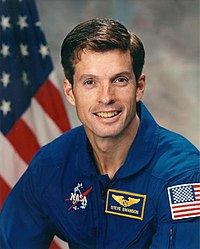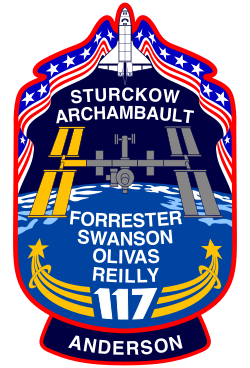Steven Swanson
| Steven Swanson | |
|---|---|
 | |
| Land | USA |
| Organisation | NASA |
| ausgewählt | 4. Juni 1998 (17. NASA-Gruppe) |
| Einsätze | 3 Raumflüge |
| Start des ersten Raumflugs | 8. Juni 2007 |
| Landung des letzten Raumflugs | 11. September 2014 |
| Zeit im Weltraum | 195d 20h 47min |
| EVA-Einsätze | 5 |
| EVA-Gesamtdauer | 27h 58min |
| Raumflüge | |
| |
Steven Ray Swanson (* 3. Dezember 1960 in Syracuse, New York, USA) ist ein ehemaliger US-amerikanischer Astronaut.
Ausbildung
Aufgewachsen ist Swanson in Steamboat Springs (Colorado), wo er bis 1979 die High School besuchte. Anschließend studierte er in Boulder an der University of Colorado Technische Physik. Nach seinem Bachelordiplom belegte er an der Florida Atlantic University das Fach Informatik und erhielt 1986 den Mastertitel.
Swanson arbeitete danach ein Jahr als Softwareingenieur bei der Kommunikationsfirma GTE (seit 2000 Verizon Wireless) in Arizona, bis er zur NASA wechselte. Am Johnson Space Center (JSC) in Houston (Texas) kümmerte er sich zunächst um das Shuttle Training Aircraft (STA), das den Astronauten als Übungsflugzeug dient. Das STA ist mit einem Bordcomputer ausgestattet, der es erlaubt, das Flugverhalten einer Raumfähre beim Landeanflug zu simulieren. Daneben setzte er sein Informatikstudium fort und promovierte 1998 an der Texas A&M University.
Astronautentätigkeit
Als einer von 17 Missionsspezialisten wurde Swanson im Juni 1998 vorgestellt, nachdem er sich bereits zwei Jahre zuvor erfolglos beworben hatte. Aus insgesamt 2.618 Bewerbern, die den formalen Auswahlkriterien entsprachen, waren 101 Finalisten hervorgegangen. Diese wurden im Herbst 1997 ins JSC zu Tests, Gesprächen und medizinischen Untersuchungen eingeladen. Im Anschluss an die zweijährige Grundausbildung wurde er in der Raumstations- und der Robotikabteilung eingesetzt.
STS-117
Seit dem Frühjahr 2005 bereitete sich Swanson auf seinen ersten Raumflug vor, der unter der Bezeichnung STS-117 im Juni 2007 stattfand. Die Atlantis brachte das S3/S4-Element zur Internationalen Raumstation (ISS). Zusammen mit Patrick Forrester führte er zwei der vier Außenbordeinsätze durch. Dabei wurden das S3/S4-Bauteil an die Station montiert, die Solarpaneele aus- und der zweite Flügel des Solarmoduls P6 eingefahren.
STS-119
Im Oktober 2007 wurde er für die Weltraummission STS-119 eingeteilt. Bei dieser Space-Shuttle-Mission wurde das letzte Solarzellenelement der ISS ins All gebracht. Der Start erfolgte am 15. März 2009. Die STS-119-Mission ging am 28. März 2009 mit der Landung am Kennedy Space Center in Florida erfolgreich zu Ende.
ISS-Langzeitaufenthalt
Am 25. Juli 2011 wurde Swanson als Reserve-Bordingenieur für die ISS-Expeditionen 37 und 38 eingeteilt, kam aber nicht zum Einsatz. Für die nächste verfügbare Expedition rückte er dann in die Hauptmannschaft auf. Der Start des Raumschiffs Sojus TMA-12M erfolgte am 25. März 2014, die Kopplung an die ISS mit zwei Tagen Verspätung am 27. März.[1] Während der Expedition 39 arbeitete Swanson als Bordingenieur. Nach dem Abdocken von Sojus TMA-11M am 13. Mai 2014 übernahm er das Kommando der ISS-Expedition 40. Am 11. September 2014 erfolgte die Rückkehr zur Erde.
Privates
Swanson ist mit Mary Drake Young verheiratet und hat drei Kinder.
Siehe auch
- Liste der Raumfahrer
- Liste der Space-Shuttle-Missionen
- Liste bemannter Missionen zur Internationalen Raumstation
- Liste der Weltraumausstiege
Weblinks
- Kurzbiografie von Steven Swanson bei spacefacts.de
- NASA-Biografie von Steven Swanson (englisch; PDF)
- Biografie von Steven Swanson in der Encyclopedia Astronautica (englisch)
Einzelnachweise
- ↑ Günther Glatzel: Sojus-TMA 12M an ISS gekoppelt. raumfahrer.net, 28. März 2014, abgerufen am 28. März 2014.
| Personendaten | |
|---|---|
| NAME | Swanson, Steven |
| ALTERNATIVNAMEN | Swanson, Steven Ray |
| KURZBESCHREIBUNG | US-amerikanischer Astronaut |
| GEBURTSDATUM | 3. Dezember 1960 |
| GEBURTSORT | Syracuse (New York), New York, Vereinigte Staaten |
Auf dieser Seite verwendete Medien
ISS Expedition 39 Patch
Increment 39 of the International Space Station Program marks the 15th year of operation since the start of the space laboratory assembly. Today, the U.S., Russia, Japan, Canada and the European Space Agency are partnering in the operation of the largest ever orbital outpost managed by humankind. The names of the six crew members are depicted in their native languages. For Expedition 39, the Soyuz spacecraft serves as transport vehicle for the crew members to and from the station. During this expedition, the ISS will serve as a platform for scientific research, Earth and astronomical observation, education, as well as a stage for the development of new technologies used for the exploration beyond low Earth orbit. The star above the complex signifies human space exploration towards new frontiers. The crew members added these words: "The crew of Expedition 39 is proud to serve the international community in furthering our scientific knowledge and in expanding human presence in space."
The Expedition 40 patch depicts the past, present, and future of human space exploration. The crew wrote the description that follows: The reliable and proven Soyuz, our ride to the International Space Station (ISS), is a part of the past, present, and future. The ISS is the culmination of an enormous effort by many countries partnering to produce a first-class orbiting laboratory, and its image represents the current state of space exploration. The ISS is immensely significant to us as our home away from home and our oasis in the sky. The commercial cargo vehicle is also part of the current human space exploration and is a link to the future. A blend of legacy and future technologies is being used to create the next spacecrafts which will carry humans from our planet to destinations beyond. The sun on Earth's horizon represents the new achievements and technologies that will come about due to our continued effort in space exploration.
The STS-117 crew patch symbolizes the continued construction of the International Space Station (ISS) and our ongoing human presence in space. The ISS is shown orbiting high above the Earth. Gold is used to highlight the portion of the ISS that will be installed by the STS-117 crew. It consists of the second starboard truss section, S3/S4, and a set of solar arrays. The names of the STS-117 crew are located above and below the orbiting outpost. The two gold astronaut office symbols, emanating from the '117' at the bottom of the patch represent the concerted efforts of the shuttle and station programs toward the completion of the station. The orbiter and unfurled banner of red, white and blue represent our Nation's renewed patriotism as we continue to explore the universe.
The shape of the STS-119/15A patch comes from the shape of a solar array viewed at an angle. The International Space Station (ISS), which is the destination of the mission, is placed accordingly in the center of the patch just below the gold astronaut symbol. The gold solar array of the ISS highlights the main cargo and task of STS-119/15A -- the installation of the S6 truss segment and deployment of S6's solar arrays, the last to be delivered to the ISS. The surnames of the crew members are denoted on the outer band of the patch. The 17 white stars on the patch represent, in the crew's words, "the enormous sacrifice the crews of Apollo 1, Challenger, and Columbia have given to our space program." The U.S. flag flowing into the space shuttle signifies the support the people of the United States have given our space program over the years, along with pride the U.S. astronauts have in representing the United States on this mission.




